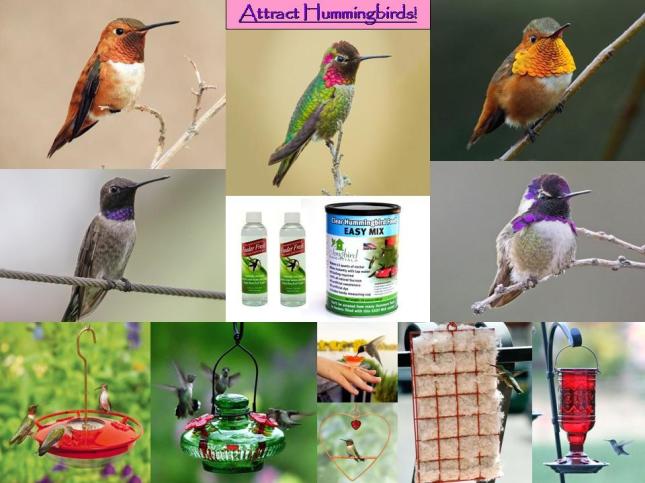
Who Are Our Local Species?
Anna's Hummingbird (top center)
Rufous Hummingbird (top left)
Allen's Hummingbird (top right)
Black-chinned Hummingbird (middle left)
Costa's Hummingbird (middle right)
How to Attract Hummingbirds
Nectar Producing Plants
Hummingbird Nectar Feeders
Hummingbird Feeders come in a variety of shapes, styles, and colors.
Feeder Placement
Consider where you want to view your Hummingbird Feeders
Indoor/Outdoor Viewing
- Hang under eaves outside of Frequently used windows and patios
- Front or Back yard
Height
- 5 to 6 feet above the ground
Sun or Shade
- Nectar keeps longer in shade than in direct sun
Wind
- Try to place feeders in a wind sheltered area
- Have heavier feeders that can better handle strong winds
Feeder Considerations
Nectar Capacity
- Larger Capacity means it won't need to be refilled are frequently (still keep nectar fresh)
- Smaller Capacity allows one to put less out at a time making it easier to keep the nectar fresh
Number of Feeding Ports
- Limited on how many hummingbirds can drink at once
- Hummingbirds are naturally territorial over nectar sources and will attempt to chase others hummingbirds away
Ease of Cleaning
- It is important to routinely clean and maintain your hummingbird feeder
- Saucer feeders are generally easier to clean
Glass or Plastic
Glass
- Longer Lasting, easier to keep clean, can break if feeder falls
Plastic
- Less likely to break if feeder falls, relatively inexpensive, can warp and discolor with soft plastics
Nectar
Hummingbird Nectar is intended to duplicate Flower nectar
Nectar Options
Easy Mix - Finely grained sugar that dissolves easily in water
Concentrate - just add water
Ready to Use - ready for the feeder straight out of the container
Make Your Own - Using a 1:4 Ratio, dissolve 1 cup of refined white granulated sugar to 4 cups of water
How Often Should Hummingbird Nectar Be Changed?
Fall & Winter - 1 to 2 times per week
Spring & Summer - 2 to 3 times a week
Hot Summer Days - Daily to every other day
Extend the life of your nectar with Nectar Defender
- Nectar Defender is a copper solution that is added to fresh nectar
- It helps prolog the life of the nectar up to 2 weeks (Even on high heat days)
A Note On Nectar Additions
Artificial Dyes
- It is not necessary to add dyes to your nectar
- Flower nectar is naturally clear
- Most Hummingbird Feeders already have red coloration on the feeder itself
- Artificial dyes may potentially be harmful to the Hummingbirds
Honey
- Honey can cause fatal fungus infection in Hummingbirds
Corn Syrup and raw unprocessed sugars
- Often contains additional ingredients and is not recommended for hummingbird nectar
Insects
- 10% of the Hummingbird diet are small flying insects.
- Avoid using insecticide in your yard
Water
Moving Water is more attractive to Hummingbirds than standing water. especially fountains and bubblers.
Ants, Bees & Wasps

